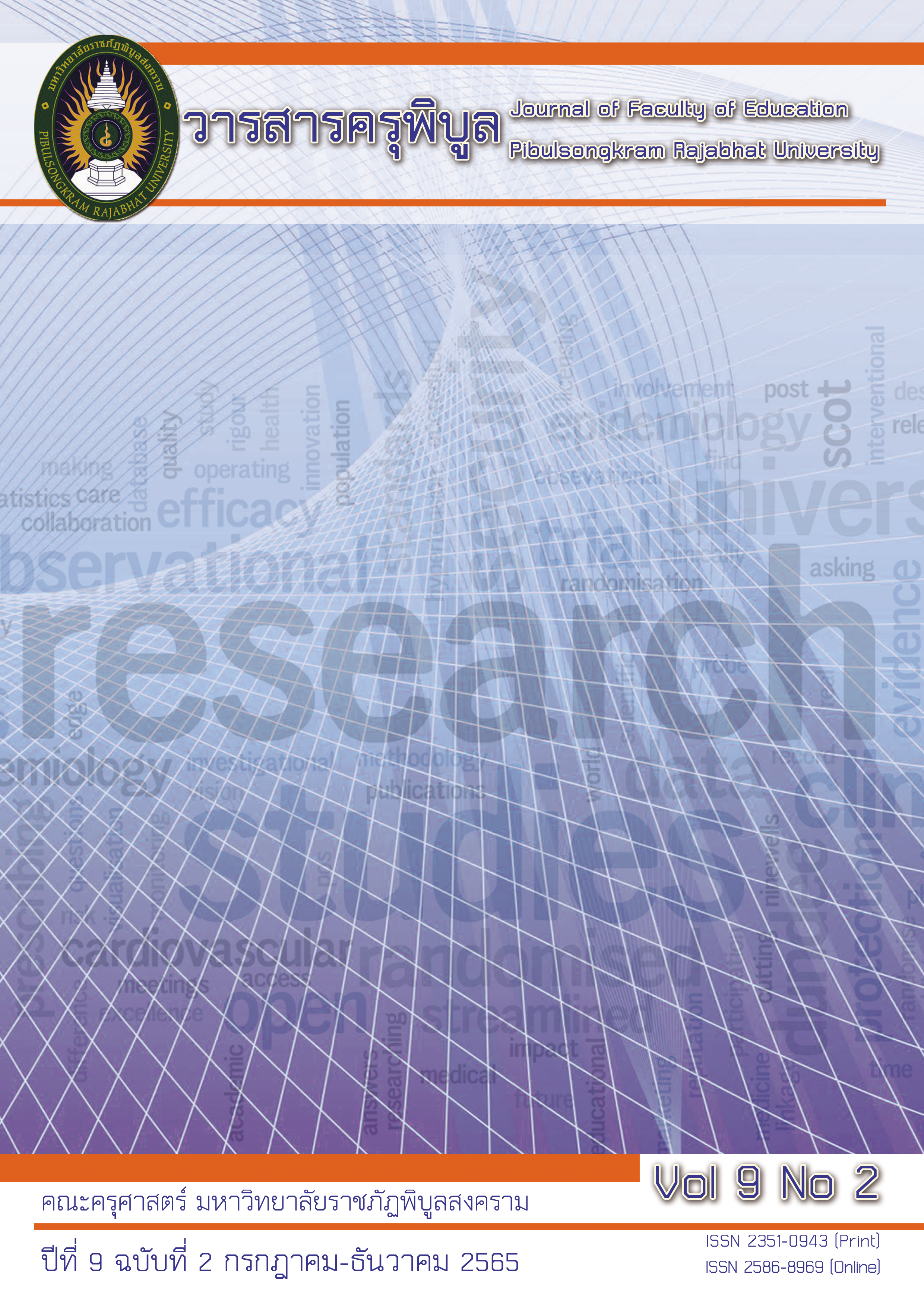การเรียนการสอนออนไลน์ผ่านแอปพลิเคชันในยุค 5G
การเรียนการสอนออนไลน์ผ่านแอปพลิเคชันในยุค 5G
คำสำคัญ:
การเรียนการสอนออนไลน์ การเรียนผ่านแอปพลิเคชัน เทคโนโลยี 5G, การเรียนการสอนออนไลน์, การเรียนผ่านแอปพลิเคชัน, เทคโนโลยี 5Gบทคัดย่อ
เทคโนโลยีทางด้านการสื่อสารโทรคมนาคมมีการพัฒนาและมีความก้าวหน้าอยู่เสมอ นำไปสู่การเปลี่ยนผ่านสู่ยุค 5G ที่มีแนวโน้มการใช้งานมากขึ้นและจะเป็นสิ่งที่เชื่อมโลกเข้าด้วยกันทุกที่ทุกเวลาด้วยเครือข่ายอินเทอร์เน็ต โดยการพัฒนาแอปพลิเคชันเพื่อลดความเหลื่อมล้ำทางด้านดิจิทัลถือเป็นการเพิ่มโอกาสในการเข้าถึงเทคโนโลยี จึงมีการนำเทคโนโลยี 5G มาใช้ในการเรียนการสอน ซึ่งมีการนำมาใช้ในการเรียนการสอนออนไลน์ผ่านแอปพลิเคชันโปรแกรมการประชุมออนไลน์ เช่น โปรแกรม Zoom, Google Meeting, Skype เป็นต้น โดยข้อดีของการจัดการเรียนการสอนแบบออนไลน์ผ่านแอปพลิเคชันต่างๆ นั้น คือ ทำให้การสื่อสารแบบ real time มีความเร็วที่มากขึ้น ภาพคมชัดขึ้น ไม่สะดุด นอกจากนี้การให้บริการของเทคโนโลยี 5G ทำให้ผู้สอนสามารถจัดการเรียนรู้แบบห้องเรียนเสมือน (Virtual Classroom) ซึ่งผู้เรียนสามารถเข้าร่วมกิจกรรมต่างๆ มีปฏิสัมพันธ์ระหว่างผู้สอนกับผู้เรียน หรือผู้เรียนกับผู้เรียนผ่านเครือข่ายอินเทอร์เน็ตได้จากทุกที่เป็นการเพิ่มความสามารถในการสื่อสารตอบโต้ โดยสามารถส่งข้อมูลพร้อมกันได้ 2 ทิศทางในเวลาเดียวกัน ซึ่งการออกแบบแอปพลิเคชันเพื่อใช้ในการเรียนการสอนออนไลน์ในยุค 5G นั้นจำเป็นต้องวางแผนและออกแบบในด้านต่าง ๆ ได้แก่ หน้าจอ มัลติมีเดีย และปฏิสัมพันธ์ นอกจากการพัฒนาแอปพลิเคชันเพื่อการเรียนรู้ที่มีคุณภาพจะต้องมีเนื้อหาที่เข้าใจง่ายแล้ว ต้องมีการออกแบบหลักสูตร การประเมินผลการเรียน และการเรียนการสอนที่เหมาะสมกับผู้เรียนทั้งในด้านทักษะการเรียนรู้ ความพร้อมของทรัพยากร และการเข้าถึงเทคโนโลยีเพื่อที่จะทำให้ผู้เรียนที่เรียนออนไลน์ผ่านแอปพลิเคชันมีความเข้าใจเนื้อหามากยิ่งขึ้น
เอกสารอ้างอิง
กรกนก คลังบุญครอง. (2555). เว็บแอปพลิเคชันช่วยแม่ดูแลสุขภาพและบันทึกพัฒนาการของลูก.
วิทยาศาสตรบัณฑิต มหาวิทยาลัยเทคโนโลยีพระจอมเกล้าธนบุรี.
ชินวัจน์ งามวรรณากร. (2562). การพัฒนาแอปพลิเคชันสื่อการเรียนรู้บนอุปกรณ์เคลื่อนที่ เรื่อง
ภาษาอังกฤษสำหรับนักสารสนเทศ. คณะมนุษยศาสตร์และสังคมศาสตร์ มหาวิทยาลัยราชภัฏยะลา.
ธนชพร พุ่มภชาติ และคณะ. (2563). การจัดการศึกษาไทยในยุค 5G. วารสารวิชาการมหาวิทยาลัยอีสเทิร์น
เอเชีย ฉบับสังคมศาสตร์และมนุษยศาสตร์, 10(3), 31-38.
เทอดพงษ์ แดงสี และพิสิฐ พรพงศ์เตชวาณิช. (2562). 5G: เทคโนโลยีการสื่อสารแห่งทศวรรษหน้า.
วารสารวิชาการเทคโนโลยีอตุสาหกรรม, 15(2), 162-180.
พิมพ์ปวีณ์ สุวรรณโณ. (2563). การพัฒนาแอปพลิเคชันเพื่อการเรียนรู้ รายวิชาการวิจัยทางการศึกษา
บนระบบปฏิบัติการแอนดรอยด์ สําหรับนักศึกษาชั้นปีที่ 4 มหาวิทยาลัยราชภัฏยะลา. วารสารกลุ่มมนุษยศาสตร์ – สังคมศาสตร์, 3(1), 38-49.
ภาสกร เรืองรอง. (2551). การประยุกต์ใช้บทเรียนบนเครือข่าย WBI กับขั้นตอนการสอน 9 ขั้นของกาเย่. สืบค้นเมื่อ 25 มีนาคม 2564, จาก
http://www.thaiwbi.com/topic/WBI_Gagne/WBI_Gagne.pdf
รัชนีวรรณ ชาวนา. (2562). 5G เทคโนโลยีขับเคลื่อนการปฏิวัติอุตสาหกรรมครั้งที่ 4 สู่ไทยแลนด์ 4.0.
วารสารวัตกรรมสังคม, 2(2), 93-111.
รุ้งนภาพร ภูชาดา และ สวียา สุรมณี. (2558). การพัฒนาแอพพลิเคชั่นเพื่อการเรียนรู้บนแท็บเล็ต
เรื่ององค์ประกอบของระบบสารสนเทศ สำหรับชั้นมัธยมศึกษาปีที่ 4. วารสารโครงงานวิทยาการคอมพิวเตอร์และเทคโนโลยีสารสนเทศ, 1(2), 18-25.
วิทยา วาโย และคณะ. (2563). การเรียนการสอนแบบออนไลน์ภายใต้สถานการณ์แพร่ระบาด ของไวรัส
COVID-19: แนวคิดและการประยุกต์ใช้จัดการเรียนการสอน. วารสารศูนย์อนามัยที่ 9, 14(34), 285-298.
สำนักงานคณะกรรมการกิจการกระจายเสียง กิจการโทรทัศน์ และกิจการโทรคมนาคมแห่งชาติ. (2561). 5G:
คลื่นและเทคโนโลยี. สืบค้นเมื่อ 5 มีนาคม 2564, จากhttp://www.nbtc.go.th/getattachment/Services/quarter2560.pdf.aspx
ดาวน์โหลด
เผยแพร่แล้ว
ฉบับ
ประเภทบทความ
สัญญาอนุญาต
ลิขสิทธิ์ (c) 2022 คณะครุศาสตร์ มหาวิทยาลัยราชภัฏพิบูลสงคราม

อนุญาตภายใต้เงื่อนไข Creative Commons Attribution-NonCommercial-NoDerivatives 4.0 International License.
ลิขสิทธิ์เป็นของคณะครุศาสตร์ มหาวิทยาลัยราชภัฏพิบูลสงคราม


